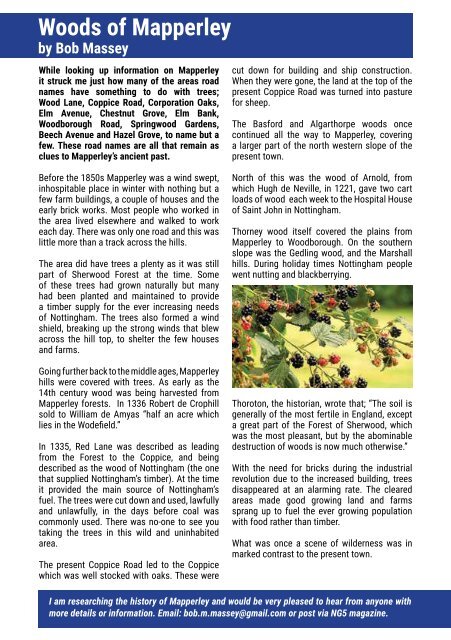NG3 July/August 2020
Local business directory and community magazine
Local business directory and community magazine
You also want an ePaper? Increase the reach of your titles
YUMPU automatically turns print PDFs into web optimized ePapers that Google loves.
Woods of Mapperley<br />
by Bob Massey<br />
While looking up information on Mapperley<br />
it struck me just how many of the areas road<br />
names have something to do with trees;<br />
Wood Lane, Coppice Road, Corporation Oaks,<br />
Elm Avenue, Chestnut Grove, Elm Bank,<br />
Woodborough Road, Springwood Gardens,<br />
Beech Avenue and Hazel Grove, to name but a<br />
few. These road names are all that remain as<br />
clues to Mapperley’s ancient past.<br />
cut down for building and ship construction.<br />
When they were gone, the land at the top of the<br />
present Coppice Road was turned into pasture<br />
for sheep.<br />
The Basford and Algarthorpe woods once<br />
continued all the way to Mapperley, covering<br />
a larger part of the north western slope of the<br />
present town.<br />
Before the 1850s Mapperley was a wind swept,<br />
inhospitable place in winter with nothing but a<br />
few farm buildings, a couple of houses and the<br />
early brick works. Most people who worked in<br />
the area lived elsewhere and walked to work<br />
each day. There was only one road and this was<br />
little more than a track across the hills.<br />
The area did have trees a plenty as it was still<br />
part of Sherwood Forest at the time. Some<br />
of these trees had grown naturally but many<br />
had been planted and maintained to provide<br />
a timber supply for the ever increasing needs<br />
of Nottingham. The trees also formed a wind<br />
shield, breaking up the strong winds that blew<br />
across the hill top, to shelter the few houses<br />
and farms.<br />
Going further back to the middle ages, Mapperley<br />
hills were covered with trees. As early as the<br />
14th century wood was being harvested from<br />
Mapperley forests. In 1336 Robert de Crophill<br />
sold to William de Amyas “half an acre which<br />
lies in the Wodefield.”<br />
In 1335, Red Lane was described as leading<br />
from the Forest to the Coppice, and being<br />
described as the wood of Nottingham (the one<br />
that supplied Nottingham’s timber). At the time<br />
it provided the main source of Nottingham’s<br />
fuel. The trees were cut down and used, lawfully<br />
and unlawfully, in the days before coal was<br />
commonly used. There was no-one to see you<br />
taking the trees in this wild and uninhabited<br />
area.<br />
The present Coppice Road led to the Coppice<br />
which was well stocked with oaks. These were<br />
North of this was the wood of Arnold, from<br />
which Hugh de Neville, in 1221, gave two cart<br />
loads of wood each week to the Hospital House<br />
of Saint John in Nottingham.<br />
Thorney wood itself covered the plains from<br />
Mapperley to Woodborough. On the southern<br />
slope was the Gedling wood, and the Marshall<br />
hills. During holiday times Nottingham people<br />
went nutting and blackberrying.<br />
Thoroton, the historian, wrote that; “The soil is<br />
generally of the most fertile in England, except<br />
a great part of the Forest of Sherwood, which<br />
was the most pleasant, but by the abominable<br />
destruction of woods is now much otherwise.”<br />
With the need for bricks during the industrial<br />
revolution due to the increased building, trees<br />
disappeared at an alarming rate. The cleared<br />
areas made good growing land and farms<br />
sprang up to fuel the ever growing population<br />
with food rather than timber.<br />
What was once a scene of wilderness was in<br />
marked contrast to the present town.<br />
I am researching the history of Mapperley and would be very pleased to hear from anyone with<br />
more details or information. Email: bob.m.massey@gmail.com or post via NG5 magazine.


















